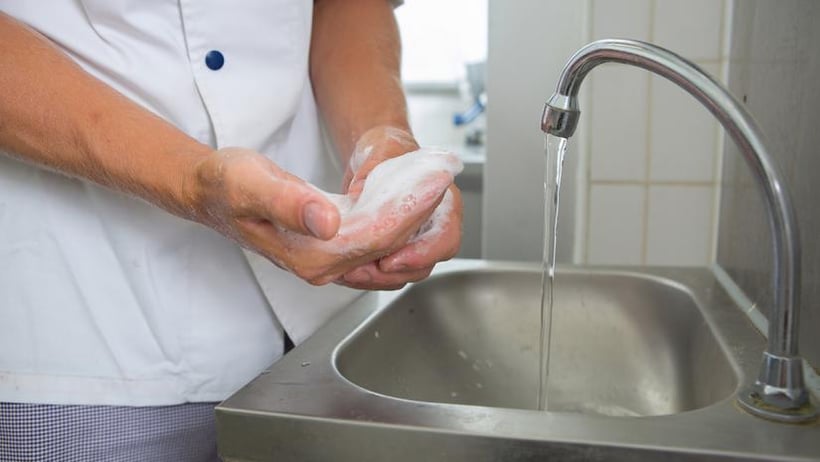
Since the beginning of the COVID-19 pandemic, food businesses have had to incorporate many new health and safety protocols. They have had to pivot their business operations in order to ensure the health and safety of their staff and customers. As time passes, these best practices are just as important as they were a few months ago. This is especially true with some food businesses being able to conduct dine-in service now in some provinces and territories. Here is a breakdown of the best practices that food businesses must not forget.
Hygiene
Hand washing
Hygiene protocols such as proper hand washing have always been a key part of food safety training, even before the COVID-19 pandemic. Thorough and frequent hand washing is one of the most important things a Food Handler can do to ensure safety in the workplace. Hand washing with soap and water is proven to be more effective against certain pathogens, and can help to curb the spread of COVID-19.
Training staff on the proper hand washing technique quickly became one of the best practices food businesses could do while operating during the early days of the pandemic. Recently, many food businesses have reopened for dine-in service, or may be reopening soon. As food businesses begin to welcome customers back into their premises, enforcing the proper hand-washing technique must not fall out of practice. In fact, it is more important now than ever as food businesses begin to have more close interactions with customers.
The way to properly wash hands involves using soap and warm water and washing hands for at least 20 seconds. To learn all of the steps to washing hands properly, check out the Correct Hand Washing Method Poster in the CIFS Resource Library.
Use of hand sanitizer
Since the pandemic took hold throughout Canada, the demand and use of hand sanitizer have grown immensely. Food businesses are supplying hand sanitizer to staff members as well as customers to help kill pathogens and stop the spread of the coronavirus. This includes delivery staff and other workers who don’t have access to hand washing facilities in order to wash their hands as frequently as required. It is also common to see food businesses supplying hand sanitizer for customers at food pick-up locations or throughout the premises. The key to this practice is to keep hands as clean as possible when hand washing isn’t possible.
As Canadian food businesses begin to reopen in different fashions, it is essential that hand sanitizer continues to be provided. Reopening requires more business expenses, and it may be tempting to forgo hand sanitizer to cut costs. However, hand sanitizer ensures customers have clean hands, and it also reassures customers when they see staff members using hand sanitizer.
A word of caution about hand sanitizers: Hand sanitizer could cause chemical contamination of food if it is not allowed to properly dry on hands before preparing food. For this reason, proper training on the use of hand sanitizer is essential.
Cleaning and sanitizing
As a condition of reopening, most provinces and territories require food businesses to have a COVID-19 Plan that includes an updated cleaning and sanitizing schedule. This updated schedule includes cleaning and sanitizing high-touch objects such as menus, condiments, doorknobs, railings and trays — just to name a few. This practice is essential for killing COVID-19 and preventing its spread within a food business. It is important that food businesses check with their supplier to confirm that the sanitizer being used is effective against the coronavirus.
In the current climate, the value of the updated cleaning and sanitizing schedule is clear. As time goes on, though, food businesses may begin to slip in their cleaning and sanitizing practices and fall back into old ways. It is essential that this does not happen. While the new schedule may be time-consuming, it is vital to prevent the spread of COVID-19 and keep staff and customers safe. This is key to running a healthy, safe and successful food business.
Learn more about cleaning and sanitizing to prevent COVID-19 here.
Technology
As food businesses reopen their doors, many are turning to technology to ensure the premises are safe. High-end technology is helping food businesses to operate in a way that prevents the spread of COVID-19. Some examples include:
- Contact-free payments
- Digital menus
- Self-order stations
- Tablets for taking orders
The benefit of these pieces of technology is that they eliminate contact between customers and staff as well as between staff members. This is not only a best practice in order to operate safely, but it also makes customers feel safe and keeps them coming back.
The downside to this is that using technological enhancements can be costly. As time progresses and COVID-19 cases start to decrease, it can be tempting to move back to traditional menus, taking cash payments and ditching the tablets and screens. If financially able to do so, it is important for food businesses to continue using technology to reduce contact and reduce the risk of contracting COVID-19.
Adaptation
The COVID-19 pandemic has affected the food industry widely. From restaurants and bars to coffee shops and grocery stores, food businesses are having to adapt in order to survive these times. Food businesses must continue to prepare to adapt operations and business models for the foreseeable future. This is because it is still not clear how the pandemic will continue to affect Canada and Canadian food businesses.
There are discussions about a potential second wave and food businesses must be prepared for that possibility. This could mean more shutdowns and a switch back to take-out and delivery only. While this is not an ideal situation, being adaptive is the best way to stay the course through the pandemic.





